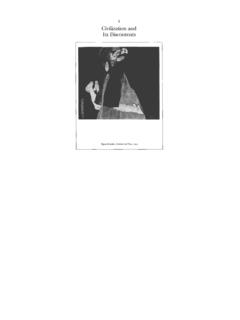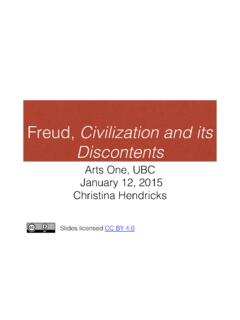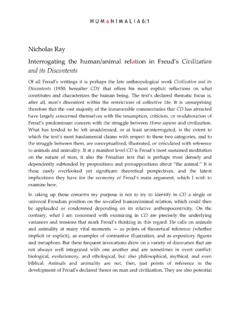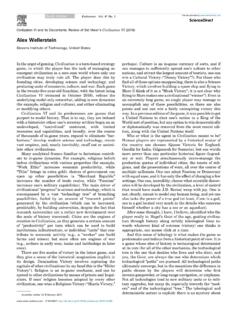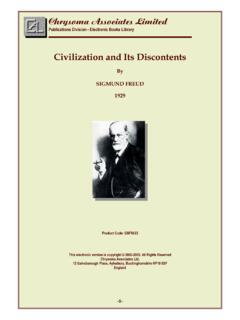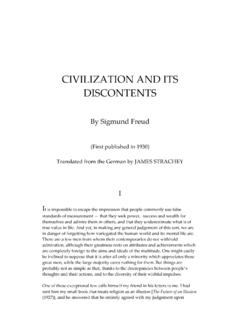Transcription of Civilization and Its Discontents: Cultural Primitivism and ...
1 Civilization and Its Discontents: Cultural Primitivism and merlin as a Wild Man in the"Roman de Silence"Author(s): LORRAINE KOCHANSKE STOCKS ource: Arthuriana, Vol. 12, No. 1, Essays on "Le Roman de Silence" (SPRING 2002), pp. 22-36 Published by: Scriptorium PressStable URL: .Accessed: 09/06/2014 19:42 Your use of the JSTOR archive indicates your acceptance of the Terms & Conditions of Use, available at ..JSTOR is a not-for-profit service that helps scholars, researchers, and students discover, use, and build upon a wide range ofcontent in a trusted digital archive. We use information technology and tools to increase productivity and facilitate new formsof scholarship.
2 For more information about JSTOR, please contact .Scriptorium Press is collaborating with JSTOR to digitize, preserve and extend access to This content downloaded from on Mon, 9 Jun 2014 19:42:47 PMAll use subject to JSTOR Terms and ConditionsCivilization and Its Discontents: Cultural Primitivism and merlin as a Wild Man in the Roman de Silence LORRAINE KOCHANSKE STOCK By depicting merlin as a Wild Man and referring allusively to Dangiers in the Roman de la Rose, Heldris engages ambivalently with the discourse of Cultural Primitivism , which expresses discontent with Civilization and promotes a natural' lifestyle as preferable to the corruption inherent in 'nurtured' civilized life.
3 (LKS) Cultural Primitivism is a discourse that expresses the discontent of the civilized with Civilization , and the belief held by people in a highly evolved and complex Cultural condition that a simpler and less sophisticated life is more desirable than that condition (Elias 3-4). It was thought that attainment of such a model human condition could be achieved by emulating some geographically distant savage' people who follow the 'norms of nature' or are said to live in a 'state of nature.' In this paradigm, this natural state is characterized by a repudiation of technology, luxury goods, private ownership, the profit motive, organized government, nationalism, wars, taxes, and the other social ills that ironically accompany the 'civilizing' Medieval Europe's complex participation in the discourse of Cultural Primitivism is attested by the belief in the Wild People, a 'savage' group whose empirical otherness paradoxically not only helped define their very concept of ' Civilization ' but offered an alternative to Civilization 's corrupting influence for those seeking escape from Civilization through Primitivism .
4 Heldris of Cornwall's controversial inclusion of merlin and depiction of him as a Wild Man in the Roman de Silence demonstrates and documents medieval Europe's ambivalent participation in For some readers and critics, the incorporation of the merlin episode so late in the plot is a serious Against this view, I argue that 'wild' merlin allows Heldris to participate in the discourse of medieval Cultural Primitivism . Significantly, Heldris s romance features the representation of the 'state of nature' as an allegorical character, Nature, whose rival for control of Silence, Norreture, represents the opposing interests of culture or Civilization . The plot also ARTHURIANA (2OO2) 22 This content downloaded from on Mon, 9 Jun 2014 19:42:47 PMAll use subject to JSTOR Terms and Conditionsmerlin as a wild man 23 revolves around many negative aspects of Civilization that inspire a desire for Cultural Primitivism : greed; the tension between art, fame, and financial fortune; dynastic anxiety over inheritance; territorial and power struggles that erupt into warfare; and the commodification of sexuality and reproduction.
5 To the received commentary that suggests ways in which this romance breaks Cultural and literary rules, I offer yet another example in Heldriss controversial employment of merlin 'Silvester in the denouement both to explore and to expose the vexing paradoxes inherent in Cultural Primitivism . However, just as Primitivism 's privileging of a simpler way of life is hardly simple, Heldriss engagement with this Cultural model is similarly vexed. On the face of it, Heldris seems literally to endorse primitivist ideals by depicting merlin as a Wild Man who prophesies and admirably privileges 'truth,' uncovering the dirty secrets of nearly all the civilized characters.
6 These secrets, involving financial or legal fraud, treason, marital infidelity, and impersonation, unquestionably implicate Civilization in a web of personal and political corruption. To a medieval audience, merlin 's presentation as a Wild Man certainly would register as an alternative or even an antidote to the discontents evoked by the artifices of Civilization . The text's attempt to indict this corruption by personifying the morally wholesome tenets of Primitivism in merlin , however, may be a case of too little and far too late. Moreover, the salutary freedom associated with Cultural Primitivism and embodied in the Wild Man is restrained, even contained, in this romance's ultimate treatment of both its hero(ine) Silence and its literary homme sauvage and truth-seeker, merlin .
7 I will situate Heldriss 'wild' characterization of the Arthurian sage within the context not only of received constructions of merlin found in a variety of medieval literary texts, but also of the mythic/ folkloric traditions about the figure of the medieval Wild Man. the medieval wild man Homme Sauvage, Homo Sylvestris, noble savage The medieval mythic 'Wild Man of the woods' represented an imagined ethnographic group whose appearance, behavior, temperament, and iconography are Classified among the monstrous races, the Wild People5 lived an outdoor existence in the unsettled and uncultivated lands of the forest outside civilized society. They were skilled hunters whose dominion over the natural world was represented in images of them wielding natural (as opposed to manufactured) weaponry, such as a huge club or an uprooted tree; riding stags, rather than the horse of the medieval knight; or This content downloaded from on Mon, 9 Jun 2014 19:42:47 PMAll use subject to JSTOR Terms and ConditionsARTHURIANA holding beasts in a posture of submission.
8 The physical trait that most differentiated this race was their long, unkempt hair, shaggy beard, and rough coat of bestial fur (Friedman 200-01). Less frequently, the Wild Mans torso is covered with grass or foliage (Husband, figure 87). Constructed as the Cultural antithesis of Civilization ,' the Wild Man was known for his uncontrolled aggression, limited or complete aphasia, and hypersexuality, all associating him with subhuman irrationality and rendering him socially According to Bernheimer, whose theoretical model of the transformation of the Wild Man from quasi-beast into the noble savage' until now has remained unchallenged, in the early medieval period the bestial Wild Man inspired fear and loathing by representing 'the abstract concept of "noncivilization" rendered as a fearful physical reality' (Husband 5).
9 In the late fourteenth century this attitude began to change. The Cultural crisis provoked by a perceived discrepancy between the ideals and the realities of the old feudal order produced a disillusionment with the state of Civilization , prompting the 'escape' offered by a reversion to a Primitivism or 'radical archaism' whose utter radicality was expressed by sympathy for or identification with the Wild Man (Bernheimer 144-45). With the Wild Man no longer considered the inferior antagonist of the knight, writers recast romances to reflect and incorporate his lifestyle, 'replacing the plate armor of the knight [with] the fur of the demon' (Bernheimer 146).
10 Although Bernheimer and those (like Husband, White, and Bartra) who accept his model are quite firm in assigning the change at earliest to the late fourteenth century (Bernheimer 144-46), the handling of Primitivism in the Roman de Silence renders this dating arguable at The affinity between Wild Man and civilized knight is not so improbable as it first seems. The European medieval Wild Man was known locally by a variety of names: agrios, homo sylvestris, hombre salvagio, uomo selvaggio, Vhomme sauvage, the ivodewose, and the wilde mann. The common denominator is the term 'man,' indicating a resemblance between mankind and the woodland-dwelling homo sylvestris.
